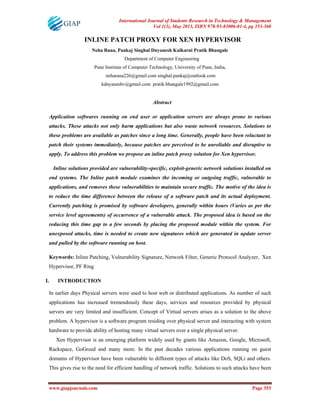This document summarizes a research paper that proposes an inline patch proxy solution for the Xen hypervisor to help address vulnerabilities more quickly. The proposed solution uses a FastPatch module to analyze incoming traffic, detect vulnerabilities based on signature matching, generate patches, and pass them to virtual machines via PF_Ring to patch vulnerabilities in seconds rather than hours. The paper outlines the design of the solution and components like Xen, PF_Ring, and an update server. It also discusses implementation of handling some SQL injection attacks and future work to address more attacks.


![International Journal of Students Research in Technology & Management
Vol 1(3), May 2013, ISBN 978-93-83006-01-4, pg 353-360
www.giapjournals.com Page 355
• Virus attacks: Applying patches requires a user to be logged into an administrative account
having modification permissions, enabling viruses that seek to modify aspects of the target
computer system, using liberal permissions, to attack.[7]
Currently vulnerabilities are handled through software patching which promises to solve the
problem within the time specified in service level agreements (usually in the order of hours or days),
after the occurrence of an attack. Reduction in the time required for patching is the urge in today's
network communication. To address this problem we propose an inline patch proxy solution for Xen
hypervisor, based on the idea of reducing the time difference between the release of a patch and its
deployment on the end system, by building an inline module which would reside within the system and
handle different attacks based on signature detection of packets.
Since Sept.19, 2012, the websites of Bank of America, JPMorgan Chase and PNC Bank (Fortune
500), have all suffered day-long slowdowns and been sporadically unreachable for many customers.
The attackers who attacked Bank of America first, went after their targets in sequence.
According to recent published reports SQL injections are the top attack vector making up 19% of all
the security breaches examined by WHID. Similarly, in the “Breach Report for 2010” released by
7Safe the same year, a whopping 60% of all breach incidents examined, involved SQL injections.[6]
Fig. 3. Distribution of attacks[8]](https://image.slidesharecdn.com/9dfbb58e-1532-440b-9041-ff5fce25cc19-170123002112/85/INLINE_PATCH_PROXY_FOR_XEN_HYPERVISOR-3-320.jpg)




